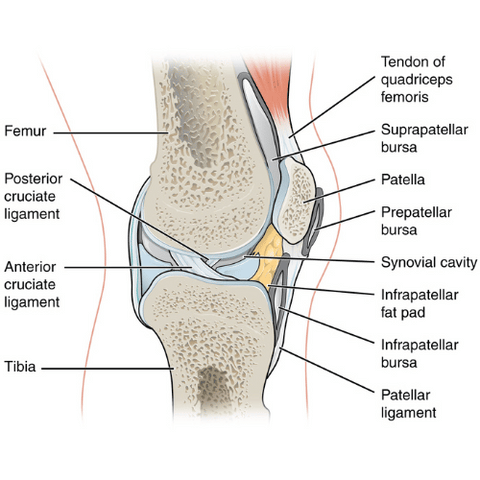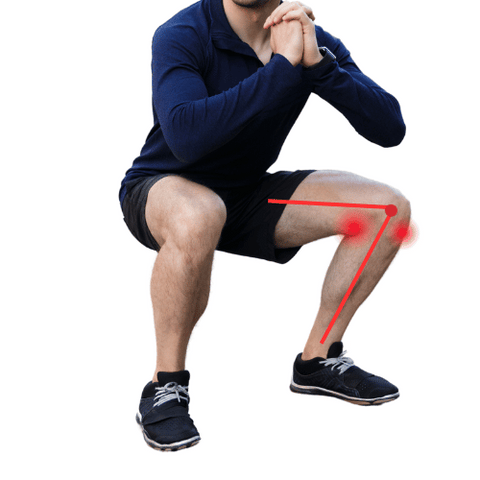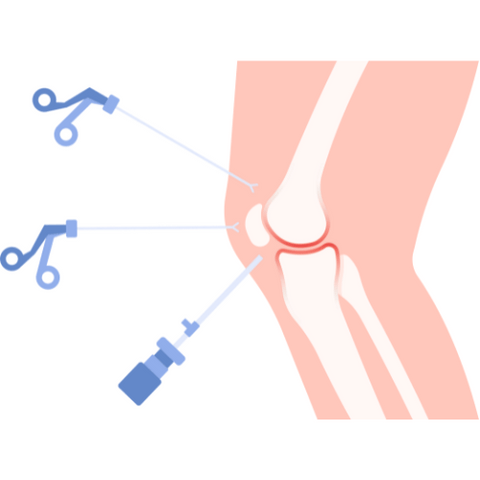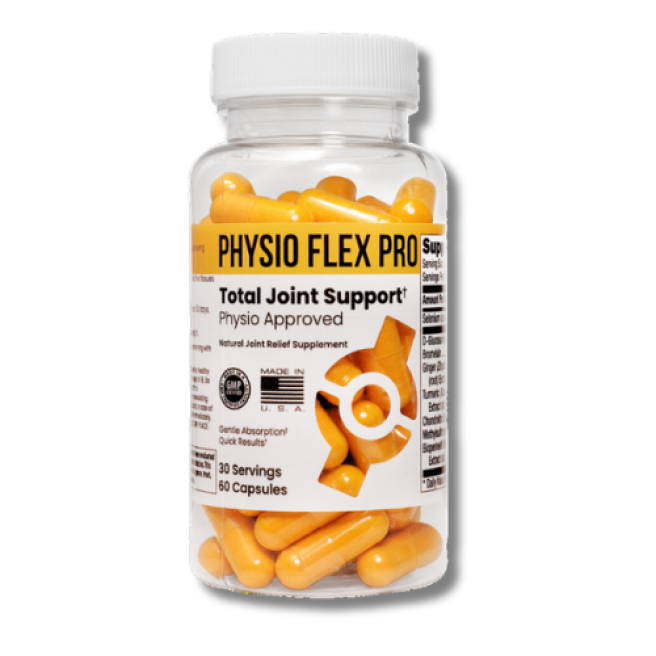So you’ve decided NOT to skip leg day, and you’re up to do some squats to get those nice thick thighs, defined calves, and buns of steel, but suddenly, you feel a sharp knee pain each time you squat down. What could be behind it?
Today, we’re discussing the importance of addressing knee pain when squatting by looking deeper into scientific studies and data that allude to its probable causes and ways to relieve and prevent it.
What Causes Knee Pain When Squatting?

The concern surrounding knee pain during squats has seen a notable uptick in recent years. Data extracted from the Ahrefs keyword tool illustrates a rising curve in search volumes, signaling an increased public awareness and encounter with this issue.
Since 2015, the search queries for knee pain associated with squatting have climbed steadily, peaking in April 2023 with a significant surge to 6800 thousand inquiries per month.
This trend reflects not just a growing problem but also a collective quest for understanding, solutions, and preventative measures. Such a swell in interest underscores the importance of addressing knee pain in the context of squatting, a fundamental movement in many fitness and rehabilitation programs.
But what are the primary causes of this pain?
Anatomy of the Knee

The knee joints are responsible for bending, standing, walking, running, swimming, and keeping balance.
The knees are composed of the following:
- Femur (thigh bone) - The femur is considered the longest, strongest bone in the body that allows one to stand and move.
- Tibia (shin bone) - The tibia is the larger of the two bones in the lower leg and is responsible for carrying the majority of the body's weight.
- Patella (kneecap) – The part that caps the femur, protecting the knee and connecting the muscles in the front of the thigh to the tibia.
- Cartilage - The tissue that covers the surface of a bone at a joint that helps reduce and soften the friction of movement within it. Worn or torn cartilage could cause clicking in the knees.
- Synovial membrane - Like the cartilage, the synovial membrane is a tissue that lines the joint. It works by secreting synovial fluid, a clear, sticky fluid that lubricates joints.
- Ligament - The ligament is an elastic connective tissue surrounding the joint to support and limit movement.
- Tendon - The tendons are strong connective tissues that connect the muscles to the bones and help control joint movement.
- Meniscus - The meniscus is a curved part of the knee cartilage and other joints. It acts like a shock absorber, deepens the knee joint, and increases the contact area.
The mechanism of joints involves a series of muscle contractions; for example, the hamstring muscles contract and pull the tibia backward, flexing the knee to bend it, while the quadricep tendon is pulled by the quadricep muscles, pulling the kneecap to extend the knee to straighten it.
Sharp Knee Pain When Squatting

Squats are a standard part of leg day workouts and are effective for building and strengthening leg and back muscles and improving core strength, with many variations of squats targeting different leg muscle groups and offering different benefits.
Doing a squat involves bending down to the knees, can place considerable stress on the knees, and can sometimes cause sharp pain, especially when done incorrectly, without warm-ups, or not being in the proper form. Muscular imbalances or weakness in the quadriceps or hamstrings can put additional stress on the knee joint during squatting.
Common Causes
Some conditions could also cause sharp knee pain when doing squats:
- Patellofemoral Pain Syndrome (PFPS) - Otherwise known as 'runner's knee,' PFPS is a condition where pain manifests in the front of the knee and around the patella (kneecap), especially during bending, kneeling, or squatting. It's often due to overuse, misalignment, or imbalance in the muscles supporting the knee.
- Meniscus tears - Meniscus tears are injuries sustained in the knee joint cartilage caused by forcefully twisting, quickly rotating, or suddenly stopping knee movements. A sharp pain can be felt depending on where the tear is, especially when squatting. While you can still walk, swelling increases daily and causes the affected knee to feel stiff.
- Cruciate ligament injuries - Conditions like ACL (anterior cruciate ligament), PCL (posterior cruciate ligament), MCL (medial collateral ligament), and LCL (lateral collateral ligament) injuries caused by stretching or straining the ligaments beyond their normal capacity, causing instability and pain in the knees, particularly during squats.
- Tendonitis - This condition is the inflammation of the tendons in the elbows, shoulders, hips, and knees. Patellar tendonitis is one of the more frequent cases of tendonitis, caused by repetitive motions that can put excessive stress on the tendon connecting the patella and shin. The pain is described as a dull ache at the top of the shinbone, right under the kneecap, and often manifests during knee bending.
- Osteoarthritis - Osteoarthritis is the most common form of arthritis that wastes away the cartilage of the joints, especially in older adults. It manifests mostly in the knees, causing great immobility. Squatting, according to studies, can cause medial knee osteoarthritis.
- Bursitis - Knee bursitis is the inflammation of the bursae, a small fluid-filled sac near the knee joint, which can lead to significant pain during movements like squatting.
- Chondromalacia patellae - A condition where the cartilage on the underside of the kneecap softens and breaks down, causing intense pain and grinding sensations. It could also eventually lead to fibrillation, fissuring, and erosion of the affected cartilage.
- Iliotibial band syndrome - IT band syndrome is the inflammation of the iliotibial band, a ligament that runs down the outside of the thigh and causes pain on the outer side of the knee. Distance runners are frequently prone to this condition.
Risk Factors
Various physical factors can lead to conditions that cause sharp knee pain:
- Age - Joint movement becomes less flexible as one ages due to two main factors – cartilage thinning and the synovial fluid decrease. The ligaments also shrink and lose flexibility, further stiffening the joints.
- Overuse and repetitive stress - Overuse knee injuries are problems with the knees caused by repetitive motion. Studies show that people working in professions like mining, construction work, and carpentry are prone to suffering overuse injuries in the knee.
- Obesity - Consuming an unhealthy diet of excess fats, sugars, grains, and other carbohydrates can directly trigger pro-inflammatory substances, gain unwanted weight, and increase knee joint stress during squatting, potentially leading to pain and strained mobility.
- Gait abnormalities - One’s gait or walking patterns can also contribute to the onset of knee pain, such as overpronation, which can cause knee pain during squatting due to improper leg alignment and weight distribution.
Other Symptoms
Aside from the sharp knee pain, other symptoms may manifest during squatting.
- Tenderness and stiffness in the knee
- Weakness or instability
- Grinding, popping, or crunching noises
If these symptoms persist, you should immediately consult your doctor or orthopedist.
Diagnosing Knee Pain
Orthopedists usually employ the following tests to diagnose knee pain:
- X-rays
- CT scans
- MRIs
- Ultrasounds
- Joint aspiration
Diagnostic Tests
In some cases, some healthcare professionals might also employ other testing methods to better observe one’s physical movements and motions through various tests and better address the root cause of the problem.
These testing methods include:
- Apley’s/McMurray/Ege’s tests - Evaluate problems of the knee meniscus
- Patellar tests - Various testing methods are available for kneecap-related problems
- Lachman test - examines and diagnoses problems with the ligaments.
- Valgus and varus stress tests - Diagnoses injuries to the collateral ligaments in the knee (or elbow).
Knee arthroscopy

Knee arthroscopy is a minimally invasive surgery that examines damage found in the cartilage and other soft tissues surrounding the joint. A small incision is made to insert a long, thin tool with a camera on the end to see and diagnose the problem.
Treatment Options
Conservative Treatments
The RICE Method
The RICE method is a first-aid self-care technique to expedite recovery from minor injuries. It stands for Rest, Ice, Compression, and Elevation:
For sharp knee pains, it can be done like this:
- Rest - Avoid any rigorous physical activity that can trigger knee joint pain
- Ice - Apply an ice pack on the afflicted joint(s) several times daily for up to 20 minutes. Don’t apply the ice directly on the affected area.
- Compression - Firmly wrap the injury with a bandage or compression sleeve. It helps speed recovery by reducing swelling and tension around the affected area.
- Elevation - Elevate the affected body part above the level of the heart to decrease swelling and joint pain.
OTC Medications
NSAIDs, COX-2 inhibitors, and analgesics help provide pain relief and mobility among people with knee joint pains. Over-the-counter pain relievers like ibuprofen (Advil), acetaminophen (Tylenol), and duloxetine (Cymbalta) are often used by people who have mild to moderate knee pain.
Alternative Therapies
Acupuncture
Acupuncture is often recommended as a complementary post-treatment therapy for knee pain to provide additional pain relief. Though it may vary individually, patients may undergo up to eight sessions to yield positive results.
Injections
Injections provide relief for joint pain from inflammation. Platelet-rich plasma (PRP) injections, for example, involve injecting a concentration of the patient’s platelets to speed up recovery of injured tendons, ligaments, muscles, and joints.
Corticosteroid injections, on the other hand, relieve inflammation, while hyaluronic acid injections lubricate the joints to help increase mobility.
Surgical Options
Joint replacement surgery
In more drastic cases, joint replacement surgery is often an option. This procedure involves replacing parts of an arthritic (partial) or an entire damaged joint (total) with a metal, plastic, or ceramic prosthesis.
Lifestyle Changes
Eating a healthy diet
Eating a healthy diet helps prevent unwanted weight gain and reduces the effects of osteoarthritis and other factors contributing to knee pain. For example, a diet consisting of oily fish like salmon or sardines, legumes, nuts, dairy, garlic, and dark leafy greens rich in omega-3 fatty acids helps strengthen the bones and promote better joint health.
Regular exercise
Various studies agree that certain low-impact exercises like brisk walking, cycling, swimming, and activities like yoga can greatly benefit the knees by strengthening the muscles around affected joints, decreasing bone loss, controlling joint swelling and pain, and increasing the production of synovial fluid around the cartilage.
Supplementation
Taking dietary supplements with anti-inflammatory ingredients can help provide effective relief against knee pain and restore mobility.
Physio Flex Pro is one such supplement complex that utilizes the power of natural, anti-inflammatory ingredients like bromelain, chondroitin, glucosamine, ginger, MSM, and selenium citrate, which are scientifically proven to support the protection and repair of key connective tissues, strengthen joint health, stop cartilage degradation, and provide pain relief.
Prevention and Management
Warm-Up and Strengthening Exercises
Before doing any type of squats, you should do some warm-up exercises to minimize the stress on the knees, thighs, and calves, especially if you’re new to squats or haven’t done them in a long time.
Here are three effective warm-up exercises that help gear you up for squats:
Knee Flexion Stretch
You’ll need a resistance band (or a towel) and a mat (optional)
- On the mat, sit with your legs extended
- Place the resistance band around one heel
- Pull the band toward you, sliding your heel toward your rear end. Keep the heel in contact with the mat.
- Hold for up to 15 seconds to feel the stretch.
- Repeat the procedure with the opposite leg.
Lunges
You can do this in one place (static) or while walking. Do 10-15 reps (20-30 alternatingly) per leg.
- Step forward with one leg into a long stride and lower into a lunge, bending both knees and keeping your posture upright.
- Try to go as low as you can. Don’t go beyond what you can reach.
- Stand back up again by driving through the front heel.
- Repeat with the opposite leg into another stride.
Air/Pulse Squats
Air or pulse squats help set you in motion before you do heavier squats and place the muscles under constant tension. They can help build strength, endurance, coordination, and stability using your own body weight.
- Stand with feet shoulder-width apart, toes pointed slightly outward, and heels flat on the floor.
- Engage the core muscles, pull shoulder blades together, and gently squat back as if you’re about to sit in a chair.
- Keep your weight in your heels so you don’t lean forward. Make sure that the glutes reach the backs of your calves.
- Hold for two seconds, then rise by pushing through heels to return to a standing position. Do as many as 15 reps.
Proper Squatting Techniques
Before you go for the plunge, make sure to remember the proper squat formation.
Using a barbell
Knee Joint Flexion When Barbell Squatting
- Position the barbell at the base of your neck or above the traps.
- Stand with your feet shoulder-width apart, toes slightly out, core engaged, and with the chest up. Inhale o
- Inhale one big breath before initiating the squat movement — push the hips back as if sitting down and with the knees bent apart outwardly.
- Make a short pause when your thighs reach about parallel to the ground.
- Exhale as you push the ground with your feet to return to the starting position.
Using dumbbells
- Hold two dumbbells at your sides. Choose a manageable weight to ensure easier motion.
- Lock your back at a straight angle and keep the abdominal muscles tight. ...
- In the same manner, as with the barbell, inhale one big breath and push the hips back as if sitting down with the knees outwardly bent apart.
- Make a short pause and exhale as you push the ground with both feet firm and flat to return to the starting position.
You can also use one dumbbell (sumo squats) by cupping it with both hands and doing the same procedures.
Recent Studies and Research
While research on the effects of exercise on knee joint pain is still in its infancy stages, recent studies show that regular exercise can help improve knee joint function. One, in particular, found that both weight-bearing and non-weight-bearing quadricep exercises yielded positive results among people aged 50 and above with osteoarthritis.
However, not all studies and trials received the same results and found certain exercises ineffective for improving OA-afflicted joints. Still, more research is still needed to fully determine the effects of exercise-based therapies for knee joint pain.
FAQs
Q: What immediate steps should I take if I experience sharp knee pain while squatting?
If you experience sharp knee pain while squatting, stop the workout immediately and employ the RICE method – Rest, Ice, Compression, and Elevation to facilitate recovery. Over-the-counter pain relievers like ibuprofen, acetaminophen, and duloxetine can also relieve pain.
Q: How can I differentiate between normal muscle soreness and serious knee pain after squatting?
Compared to ordinary muscle soreness, which comes and goes, serious knee pain is sharper, manifests in particular knee areas, and occurs in every knee movement. Serious knee pain also lasts for weeks at a time, so it’s best to consult a healthcare professional as soon as possible.
Q: Can specific stretches or warm-up exercises prevent knee pain during squatting?
Warm-up exercises such as knee flexion stretches, air squats, and lunges improve flexibility and reduce the risk of knee pain. They also minimize the stress on the knees, thighs, and calves.
Q: Can knee supports or braces help prevent knee pain when squatting, and how should I choose one?
Each has its own respective uses. Wearing knee sleeves can help improve squat performances and achieve heavier weights by offering compression stability. Knee braces, on the other hand, are mainly designed to help facilitate recovery among athletes with knee injuries while performing squats and other high-stress workouts. However, given their design, they can also limit one’s range of motion during squat performances.
Q: What dietary and lifestyle changes can I make to support knee health and prevent pain during squatting?
Start eating foods rich in omega-3 fatty acids, vitamin D, and calcium in your meals. Replace heavily processed, artificially-flavored foods and beverages with fresher whole food sources and healthier beverages to prevent inflammation. Regular, balanced exercise and sufficient rest also help remove pressure and stress from the knees.
Conclusion
High-stress and grueling they may be, squat exercises are an essential and critical part of building leg muscles and must involve proper preparation and observing the correct formation and execution to yield its intended results and reduce the risk of injuries.
If you’ve been experiencing frequent, sharp pain flare-ups in the knees during squat sessions, consult your healthcare provider immediately to get a proper diagnosis and treatment for the underlying health condition. That way, you’ll be able to recover faster and achieve better squat performances.
Remember, NEVER skip leg day!






